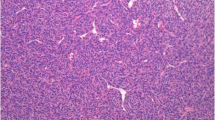Summary
Twentyone primary intracranial haemangiopericytomas (HPC) were operated on from 1953 to 1983. The mean age of the 12 male and nine female patients was 38 years (17–64). Plain skull films showed well-defined bone destruction in two patients. Angiograms of 18 tumours (14 primary and four recurrent) showed the following when analysed according to the criteria of Marc et al. [4]: dual arterial supply (17/18), one-three main feeders giving rise to many irregular corkscrewlike vessels (16/18), dense, well-defined and long-lasting tumour stain (17/18), but early venous drainage rarely (1/18). The overall impression was that eight tumours appeared to be typical HPCs on angiogram. Five tumours had suggestive features, though not enough to justify specific angiographic diagnosis, and five were more like classical meningiomas. The larger tumours were more typical of HPCs, the smaller ones resembled meningiomas.
CT scans of eight tumours (three primary and five recurrent) were available. The tumours were attached with a broad base to the convexity or other dural surfaces, often bilaterally. No calcifications were seen. There was little, if any, surrounding oedema. Contrast enhancement was strong and homogeneous. Four of the tumours were ring like, but the ring was thick and regular, in contrast to that in glioblastomas. The tumour margin was well-defined and smooth in three tumours, and nodular margins were seen in five; two of the latter grew extensively along dural surfaces. This sign may suggest aggressive biological behaviour. If both angiograms and CT scans are available, HPCs can be differentiated from glioblastomas and classical meningiomas, but perhaps not from anaplastic meningiomas.
Similar content being viewed by others
References
Enzinger FM, Smith BH (1976) Hemangiopericytoma. An analysis of 106 cases. Hum Pathol 7:61–82
Goellner JR, Laws ER, Soule EH, Okazaki H (1978) Hemangiopericytoma of the meninges. Mayo Clinic experience. Am J Clin Pathol 70:375–380
Pitkethly DT, Hardman JM, Kempe LG, Earle KM (1970) Angioblastic meningiomas. Clinicopathological study of 81 cases. J Neurosurg 32:539–544
Marc JA, Takei Y, Schechter MM, Hoffman JC (1975) Intracranial hemangiopericytomas. Angiography, pathology and differential diagnosis. Radiology 125:823–832
Mikhael MA, Gore RM, Ciric IS (1982) CT appearance of intracranial hemangiopericytoma. J Comput Assist Tomogr 6: 32–34
Jellinger K, Slowik F (1975) Histological subtypes and prognostic problems in meningiomas. J Neurol 208:279–298
Rubinstein LJ (1972) Tumors of the central nervous system. In: Atlas of tumor pathology series 2, fasc 6 Armed Forces Institute of Pathology. Washington DC, pp 187
Yamakawa Y, Kinashita K, Fukui M, Mihara K, Koga K, Kitamura K (1980) Radiosenstive meningioma. Surg Neurol 13: 471–475
Banna M, Appleby A (1969) Some observations on the angiography of supratentorial meningiomas. Clin Radiol 20:375–386
Yaghmai I (1978) Angiographic manifestations of soft-tissue and osseous hemangiopericytomas. Radiology 126:653–659
New PFJ, Aronow S, Hesselink JR (1980) National Cancer Institute study: Evalution of CT in the diagnosis of intracranial neoplasms. Meningiomas. Radiology 136:665–675
Pullicino P, Kendall BE, Jakubowski J (1980) Difficulties in diagnosis of intracranial meningiomas by computed tomography. J Neurol Neurosurg Psychiatry 43:1022–1029
Russell EJ, George AE, Kricheff II, Budzilovich G (1980) Atypical computed tomographic features of intracranial meningioma. Radiology 135:673–682
Dietemann JL, Heldt N, Burguet JL, Medjek L, Maitrot D, Wackenheim A (1982) CT findings in malignant meningiomas. Neuroradiology 23:207–209
New PFJ, Hesselink JR, O'Carroll CP, Kleinman GM (1982) Malignant meningiomas: CT and histologic criteria, including a new CT sign. AJNR 3:267–276
Vassilouthis J, Ambrose J (1979) Computerized tomography scanning appearances of intracranial meningiomas. An attempt to predict the histological features. J Neurosurg 50: 320–327
Potts DG, Abbott GF, Sneidern v. JV (1980) National Cancer Institute study: Evaluation of CT in the diagnosis of intracranial neoplasms. Metastatic tumors. Radiology 136:657–664
Steinhoff H, Lanksch W, Kazner E, Grumme T (1977) Computed Tomography in the diagnosis and differential diagnosis of glioblastomas. A qualitative study of 295 cases. Neuroradiology 14:193–200
Angervall L, Kindblom LG, Nielsen JM, Stener B, Svendsen P (1978) Hemangiopericytoma. A clinicopathologic, angiographic and microangiographic study. Cancer 42:2412–2427
Author information
Authors and Affiliations
Rights and permissions
About this article
Cite this article
Servo, A., Jääskeläinen, J., Wahlström, T. et al. Diagnosis of intracranial haemangiopericytomas with angiography and CT scanning. Neuroradiology 27, 38–43 (1985). https://doi.org/10.1007/BF00342515
Received:
Issue Date:
DOI: https://doi.org/10.1007/BF00342515




